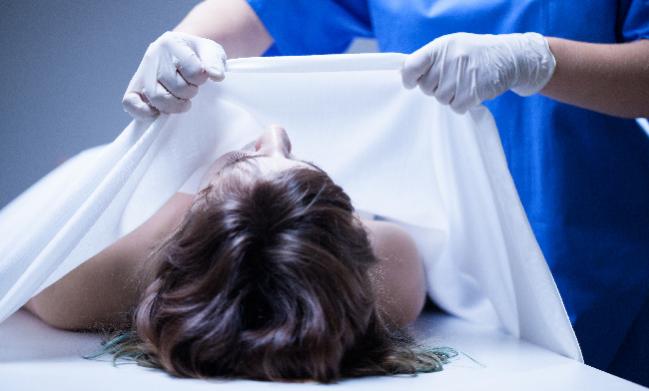Avoiding Autopsy: CT and Coronary Angiography Can Play a Role Postmortem
It might be possible to forego invasive autopsy in about 90% of nonsuspicious, sudden deaths in adults using imaging modalities.

Computed tomography and coronary angiography are typically used to save or improve lives, not to investigate deaths. But for adults who die suddenly in the absence of suspicious circumstances, the use of these imaging tools may eliminate the need for the vast majority of autopsies in England and Wales, a new study suggests.
That approach provided a cause of death in 92% of cases investigated by Her Majesty’s Coroners at a single center, lead author Guy Rutty, MD (University of Leicester, England), and colleagues report in a study published recently in the Lancet.
Discrepancies with the diagnosis provided by the gold-standard approach—autopsy findings except when modified by clear information obtained from CT scans and other sources—were similarly frequent with the CT-based approach (6%) and autopsy alone (5%).
Co-author Bruno Morgan, PhD (University of Leicester), explained to TCTMD that these findings apply only to adults who have a nonsuspicious sudden death, because suspicious cases are investigated differently for legal reasons.
He said an approach of using postmortem CT scans with targeted coronary angiography would not be used to investigate cause of death in certain types of nonsuspicious cases, including those involving a patient who did not receive a diagnosis during a hospital admission despite receiving a CT scan, a patient who had sepsis without an obvious source, or a patient with a cancer that might have been related to an industrial exposure.
“But on the whole, what we’re suggesting is start with CT, and actually if it gives you all the information you want, you stop and you don’t do an autopsy,” Morgan said. Autopsy could be avoided in about 90% of cases depending on the demographics of the practice, he added.
When greater certainty than a “balance of probabilities” is needed—in cases with legal implications, for example—the postmortem investigation should include both CT with targeted angiography and invasive autopsy, he said.
Morgan noted that using CT to assist in postmortem investigations is not a new idea, with its origins dating back to the early 1980s. More recently, CT-based investigation has been proposed as an alternative to autopsy, but preliminary studies along those lines have provided discouraging results, he said. One of the problems is that investigators were using noncontrast CT and trying to diagnose CAD—the most common cause of sudden death in adults—based on coronary artery calcification alone.
To strengthen the CT-based approach, researchers added targeted coronary angiography to improve the identification of heart disease. The method currently used in Morgan’s practice involves putting a Foley catheter in the left carotid artery and moving it down into the ascending aorta until it makes contact with the aortic valve. The catheter is then pulled back, a balloon is inflated, and contrast is injected, filling the coronary arteries. The process, which is relatively straightforward and can be performed by mortuary technicians and radiographers, yields high-quality images because of the lack of movement artifacts in this setting, Morgan said.
Rutty, Morgan, and colleagues studied the potential of replacing autopsy with postmortem CT combined with targeted coronary angiography by evaluating the performance of both approaches in 210 cases in which CT was performed first, followed by autopsy. The pathologists performing the autopsies were not told about the CT findings unless they revealed a potential risk, such as tuberculosis infection.
CT-based investigation performed well and “did not overlook clinically significant trauma, occupational lung disease, or reportable disease,” according to the authors. Basing diagnosis on the CT findings did not significant affect population statistics for cause of death.
Although overall performance was similar with either autopsy or CT with targeted angiography, the CT-based strategy had an advantage for identifying trauma and hemorrhage while autopsy was superior for identifying pulmonary thromboembolism.
The authors note that postmortem CT is emerging as an alternative to autopsy in England and Wales, where invasive autopsies are frequent. , and families can opt for the less-invasive approach if it is available in their area. The caveat, Morgan said, is a CT investigation must be paid for out of pocket, whereas there is no charge for an autopsy.
But that cost might be worth it to some families if they are interested in having the postmortem investigation completed more quickly or avoiding the invasiveness of autopsy for cultural or religious reasons, Morgan said.
Although the availability of postmortem CT is “very sporadic at the moment,” more and more centers are getting the capability, he said, adding, “I think in 20 years’ time people are going to look back and say, ‘What was the fuss?’ It will be a routine thing. It’s just how long it takes to get there.”
Todd Neale is the Associate News Editor for TCTMD and a Senior Medical Journalist. He got his start in journalism at …
Read Full BioSources
Rutty GN, Morgan B, Robinson C, et al. Diagnostic accuracy of post-mortem CT with targeted coronary angiography versus autopsy for coroner-requested post-mortem investigations: a prospective, masked, comparison study. Lancet. 2017;Epub ahead of print.
Rutty and Morgan report holding a patent for a catheter used for postmortem CT enhanced with targeted coronary angiography.
Disclosures
- The study was funded by the National Institute for Health Research.
- Rutty and Morgan report holding a patent for a catheter used for postmortem CT enhanced with targeted coronary angiography.


Alexander Kharlamov